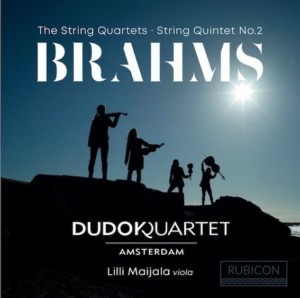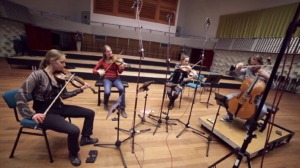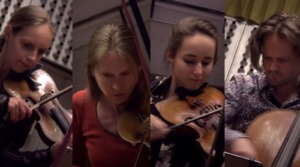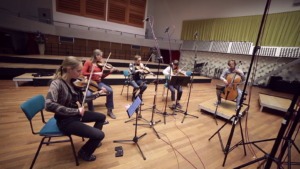As part of its focus on Brahms Third String Quartet, originally scheduled for the ‘lost’ 20-21 season, the Dudok Quartet Amsterdam commissioned Dutch writer Jan Brokken for an essay on the work. Reprinted here with permission and downloadable in both Dutch and English, Brokken’s essay is illustrated with images from the Quartet’s complete recording of Brahms String Quartets and his Second String Quintet (with violist Lilli Maijala), its debut recording for the Rubicon Classics label
Yes, beautiful, I do love Brahms

Every Brahms composition comes often suspenseful, with a nail-biting finish. His Third String Quartet, for example, popped up like a mushroom in the shadow with a story—a vivid story, of a mighty oak: his First Symphony. The quartet and the symphony were both presented to the public around the same time: the String Quartet No. 3 in B♭ major, Op. 67, had its premiere performance on 31 October 1876 in Berlin, and the Symphony No. 1 in C minor, Op. 68, was first heard in a concert hall four days later, on 4 November 1876 in Karlsruhe. Brahms described the quartet as “a useless trifle,” the opposite of “the serious countenance of a symphony.” Dreading the premiere of the First Symphony as if awaiting trial, he decided to let his beard grow and, if the critics were lenient, not shave it off. The symphony was not praised to the skies, and just after the performance in Karlsruhe Brahms made some changes to the middle sections for the performance in Vienna, but he kept the beard, and it grew into a coarse, shaggy, unkempt monstrosity that very soon took on a salt-and-pepper pattern. After the premiere of the symphony, he suddenly became an old man.
So the Third String Quartet can be described as the last Brahms without a beard. It is a remarkably light-hearted piece, lively and sometimes even cheerful—as if Brahms were saying a festive farewell to his formative years, which had been difficult and often unsparing but also tumultuous and exciting, thanks to the youthful élan that had never abandoned him. But above all, Op. 67 was a great escape into new artistic territory, which rescued Brahms from a nervous breakdown.
*
By mid-1875, Brahms was thoroughly fed up. Summer was coming down on him like a block of granite, and the city smelled like a woman who had to resort to clouds of perfume. He wanted to get out of Vienna.
Like everyone else, I associate Johannes Brahms mainly with Hamburg: with the harbour, the smell of brackish water, and a couple of seagulls peering down from on high. With sailors’ bars, music halls, and the Alster Pavilion on Binnenalster Lake, where his father would play polkas, mazurkas, and waltzes on his horn or pluck his double bass, earning more than he would have from a permanent seat in an orchestra. But not enough to buy an instrument for his son. As a young man, Hannes played piano in the waterside bars to earn back the money he’d spent on music lessons. He is even said to have sung in his high voice. Later he forced his voice lower, down to the deepest bass tones. That was around the same time that he let his beard grow.

Dudok Quartet Amsterdam recording Brahms Quartets for Rubicon Classics
Yes, Brahms goes together with low skies and the wide mouth of the Elbe, more than with the sea, which like many Hamburg natives he rarely saw. His world was framed by docks, and by the straight and narrow Protestant ways of the north, passed down to him by his deeply religious mother. After his death, Brahms received the greatest tribute possible for a son of Hamburg: all the ships in the harbor flew their flags at half-mast.
But in 1862, he had left Hamburg and slammed the door behind him, because the city fathers there did not consider him qualified to conduct an orchestra, as a musician without a conservatory education. They had snubbed him no less than three times for the position of Kapellmeister. They real problem was his family background. He had departed for Vienna, the Holy City of music and the cradle of his greatest role models: Haydn, Mozart, Schubert, Beethoven. Even before he made it his permanent home, he knew the city like the back of his hand and could point out the very palace in which Beethoven’s Eroica had rung out for the first time, the house where Schubert had mumbled, in a musty alcove, “Here, here is my end,” the theatre where the first performance of The Magic Flute had taken place, and the place where Beethoven had last directed his Ninth, so deaf that he went on waving his baton long after the orchestra had reached the end. To Brahms, Vienna was the city “where I can drink my wine in the same place where Beethoven did.” It was cosmopolitan: forty percent of the population came from across the border and the other sixty percent was mostly Hungarian. It was an aristocratic city dominated by a certain lifestyle—rather than a place to get rich quick, like Hamburg—and a bastion of Catholicism to boot, with magnificent Baroque churches. Yet those never tempted him to change his religion; as if keeping a deathbed vow to his mother, he remained a Protestant. One thing Vienna did have in common with Hamburg was a large supply of brothels. Brahms was a frequent visitor there, as he had been in Hamburg, spending time among girls who brought back memories of Gängeviertel, the impoverished district of his childhood. He knew each of them by name, and they called him Doktor Brahms; he would talk to the girls and stroke an arm now and then, not much more.
He lived in a cramped, dark apartment, Karlsgasse 4, in the shadow of the Karlskirche. In July and August, the Vienna heat was stifling and he had to get outside. Almost every summer, he found himself longing to flee the city, and in the year of our story, 1875, that feeling was stronger than ever. Where would he go? He didn’t have to wonder for long. He would seek out the green banks and fresh air of the Neckar. That May, he had turned 42, not quite old yet—and in any case, with his smooth cheeks and combed-back hair he looked good for his age. He wanted to do something to celebrate, before he grew a beard.
*
His pretext for this getaway involved a string quartet. In Vienna, an idea had come to him, a game of questions and answers between four string players, vivace… It was the kind of inspiration that clamoured for his immediate attention, but no, he had his First Symphony to work on. For years, it had weighed on his shoulders like lead, and at last it was close to completion—close, but not quite there yet. For twenty years, he had been asking himself how you could compose a symphony after Beethoven; it gnawed at him. When a troublesome orchestra complained about one of his serenades, he said from the conductor’s podium, “Gentlemen, I am aware that I am not Beethoven.” Marvelous, such critical insight into yourself, but also exhausting, like a huge obstacle you couldn’t make it over or around. He was searching for an escape route, a way to put off that terrible moment: the premiere. In every nightmare, he heard the kind of silence that causes such pain when you’re expecting an ovation, and he saw how they would label his First Symphony: traditional.
Then it came to him. In a fit of high spirits, he started work on a string quartet. He hadn’t done much of it, he told everyone around him; just the beginning. In fact, he was already well beyond that; for the second movement, he had a cantilena in mind, a delightful, lyrical melody for the first violin. He hoped to finish a little faster than he normally did, in the course of a single season in the countryside. He needed to go out into nature, wandern, spazieren — yes, that’s how German he was — and what better place than the Badische Land along the Neckar River? So he had asked a friend, the painter Anton Hanno, to come stay with him for a few weeks in Ziegelhausen. Brahms had friends all over the place, and not having a wife or children, he loved to pay them long and frequent visits. When all went well, they inspired him, and he managed to shake off his perpetual doubts.

Dudok String Quartet. Photo Merlijn Doomernik
He once confessed to his childhood friend Alwin Cranz that he had written more than twenty string quartets before three finally saw the light of day: the two that make up his Op. 51, both published in the summer of 1873 (after more than fourteen years of refinements), and the quartet on which he planned to work in Ziegelhausen. Just to be clear, let me repeat that: for his two Op. 51 quartets, he spent fourteen years between the earliest drafts and publication, making changes and corrections. In his letter to his childhood friend Cranz, he offered an explanation for his plodding creative process: “It is not difficult to compose, but what is enormously hard is to leave the superfluous notes under the table.”
Brahms conceived of the String Quartet No. 3 in B♭ major as an exceptionally light and cheerful piece, beginning with vivace and andante movements that would make a perfect match for Haydn. In other words, a Viennese work. After all, who was more Viennese than Haydn? Many years later, when the Joachim-Quartett was preparing to perform Op. 67 in Vienna, Brahms gave them some advice: “I would start the program with Haydn. That will set the mood for my quartet.”
*
Ziegelhausen is now a suburb of Heidelberg, but in 1875 it was a village surrounded by woods, hills, and orchards. Early in the morning, Brahms would follow the path to the Benedictine abbey in Neuburg, which dated from the twelfth century. Another beautiful walk went up to Heidelberg Castle. Everything about Germany that seemed so attractive, sprightly, and charming to him could be found along the Neckar. Another significant advantage of the Neckardal was the good food and fine white wine. I can imagine that certain ideas for his Third String Quartet came to him after lunch, at an outdoor café, as he sipped his last glass of wine and gazed at the river below—although, come to think of it, he preferred to eat while walking. That habit became unattractive later, once he had grown the beard, because he was always getting crumbs in the curly gray hairs, and sometimes whole chunks of sardine.
His had learned to love the Badische Land thanks to Clara Schumann. Six years after the death of her husband Robert, she had moved from Düsseldorf to a house in the Lichtental district of Baden-Baden that had just enough rooms for her eight children. She had drawn Brahms’s attention to a lovely house high on a hill in the same part of town. At that stage, he could not afford to rent the whole house, Maximilianstrasse 85, but he could manage an apartment on the second floor. From 1865 to 1874, he spent every summer there, within walking distance of Clara.
It had never bothered Brahms that Clara was fourteen years older than he was. His mother had been seventeen years older than his father: forty-one when they married. Around 1870, Clara was a portly woman who suffered from migraines and rheumatism, always dressed in black, and she made it clear in Lichtental that Brahms was visiting her strictly as a friend. After the death of Robert Schumann in 1856, she had resolved to be an exemplary widow. Until two years after Schumann’s death, Brahms addressed Clara as Frau Schumann; once they were on more informal terms with each other, he instead called her “Meine liebe Frau Mama”.
In 1875, Frau Mama did not come to Ziegelhausen. Brahms must have been disappointed; his love for Clara never faded, and he offered her the finest compliment you can give a loved one, saying she had taught him what beauty was. At the same time, her absence must have come as a relief. Clara would have been a constant reminder of the unfinished First Symphony, since she had been involved from the outset in the creation of the work.

Dudok Quartet Amsterdam: Judith van Driel & Marleen Wester violins; Marie-Louise de Jong viola; and David Faber cello
His earliest ideas had arisen soon after the twenty-year-old Johannes first met Robert and Clara. It was love at first sight for all three of them — and admiration at first hearing. Robert wrote in his diary: “Visit from Brahms. A genius.” A few weeks later, he published the famous article hailing Brahms as the long-awaited savior of German music, who would bring all its most excellent qualities to fruition. The effect was intimidating. Not only in Germany, but throughout Europe, the young man from Hamburg came to be seen as the incarnation of centuries of German music.
Brahms was also endowed with a tremendous capacity for selfcriticism, which ultimately led him to destroy more works than he published. But the idea of a symphony that would unite all the achievements of the genre had quickly taken hold of him.
The very vocal support of Clara and Robert Schumann made things extremely difficult for young Brahms. The representatives of the New German School, with Liszt and Wagner leading the way, had declared the symphony dead. By composing one, Brahms would align himself with the conservatives. But he had no wish to do that; he felt much too young and original. So he had to demonstrate that he could adhere to classical forms yet strike out in a new direction.
His first attempt failed. Some of his ideas for the symphony ended up in his First Piano Concerto and may have been what made it so formidable—even though at the premiere, only three people applauded (as Brahms confessed in a letter to Clara). Others found their way into Ein deutsches Requiem, which he composed after his mother’s death, but which was also inspired by the tragic demise of Robert Schumann. One movement of that requiem, the solemn “Denn alles Fleisch, es ist wie Gras,” was written in Lichtental, and it was also in Lichtental that Clara told him that Robert had planned to write a requiem with the same title: “A German Requiem.” The name meant merely that it was sung in the German language rather than in Latin. In the same year as Ein deutsches Requiem, Brahms composed the riotous Hungarian Dances, so lively that the listener can barely sit still. He was a bundle of contradictions.

Dudok String Quartet. Photo Merlijn Doomernik
Johannes had first met Clara and Robert Schumann in 1853. He did not send Clara the first movement of his First Symphony until 1862 (and then without the overture). By 1875 he had made great progress: the second, third, and fourth movements were as good as finished. But for the rest of the year he did not touch the composition. It was the summer of 1876 by the time he picked up the piece again on holiday in Rügen, and he wrote the majestic opening measures after he was reunited with northern skies and the view of the Baltic. It is speculated that he was thinking of Caspar David Friedrich’s Chalk Cliffs on Rügen — a meditative, almost religious painting that combines spiritual revelation with a quality of suspense emanating from the woman in red, who is so dangerously close to the edge. It must have appealed to Brahms, who had not only a rough but also a more contemplative side: he could recite long Bible passages verse for verse, the result of his religious education by his devout mother.
In late September, he played the outer movements of his symphony on the piano for Clara, who was impressed. Arnold Schönberg would later call him a “revolutionary traditionalist.”
*
Compared to that titanic struggle, composing the Third String Quartet was a walk in the park. The piece has the vitality of a rambler out on a long walk, taking in views of hills and dales and remembering treasured moments of life and love. It is his last string quartet. After the Third, he had said everything he had to say—in that genre, that is.
The quartet radiates a calm pastoral quality and a rural freshness. Brahms loved to quote the motto of his friend, the violinist Joseph Joachim: “frei aber einsam,” free but lonely. But in the summer of 1875 he came up with his own variation: “frei aber froh,” free but cheerful.
The Dutch composer Alphons Diepenbrock could not abide Brahms—too strict, too ponderous, too northern German—and regarded him as Goethian rather than Romantic. What Diepenbrock had in mind was the Goethian ideal of beauty, which he felt was behind the times in 1898. He argued that the great dramatic theme of the Romantics—the irreconcilability of Poetry with Life—eluded Brahms because he was too rationalistic; as a true son of Hamburg, a true northern German, Brahms had too much contemplative distance from the elements of his art. He lacked the “passionate force of true sensuality” so characteristic of the Romantics, Diepenbrock claimed. Instead, all he had to offer was a “soft, round, waxy, flaccid, passionless sensuality.”
I am familiar with Alphons Diepenbrock as the face of Amsterdam’s musical scene around 1900 and as Gustav Mahler’s Dutch friend. I have also encountered him Erik Menkveld’s novel Het grote zwijgen [“The Great Silence”], which portrays him as a jealous, insecure, and wounded composer. I wonder whether Diepenbrock ever heard the String Quartet No. 3, or any of Brahms’s chamber music, which vibrates with a constant tension between reality and the ideal.
Diepenbrock claims that the rigid, lackluster northern German — what a stereotype! — betrays himself most obviously in Ein deutsches Requiem, which the Dutch composer calls an impossible piece. He suggests that, in moving to Vienna, Brahms was trying to absorb the sensuality and lust for life of the Viennese—a lost cause, Diepenbrock tells us. “The music remains German in the narrow sense, not in the broad sense in which Beethoven is German and Berlioz French. It is German in the same way that Massenet in French; it represents the weak and less significant characteristics of the nationality to which it belongs.” In his firm opinion, Brahms’s German music was practically worthless “and certainly [did] not have a future”.
By way of apology for Diepenbrock, I must point out that he belonged to the generation that had been won over by Wagner’s music. He saw Wagner as the living ideal of the genius, “the master builder of a new house that will accommodate many generations to come,” while Brahms, “diligent Brahms,” was a kind of anti-Wagner, a “highly competent, artful workman” whose entire oeuvre was encapsulated in a single lament: “Auch das Schöne muss sterben” [Even beautiful things must die].
*
Brahms most certainly does not let beautiful things die in his Third String Quartet—or for that matter, in any of his works. He makes beautiful things glow like a sublime autumn—he remained in Ziegelhausen until mid-September—in full, somewhat dark, but enchanting tones. The quartet has the polyphonic structure of a distant view, the intense colours of a river valley, and the spirited rhythm of an eager and carefree walker amid that landscape. Brahms takes you on a journey from Vienna to the Badische Land.

Dudok Quartet and violist Lilli Maijala recording Brahms Second String Quintet
In the second movement, Brahms composed one of his greatest violin parts. And that is saying a great deal, since to please his friend Joachim he wrote many glorious violin pieces, from his Violin Concerto to the Rain Sonata. The melody in this movement has a melancholy beauty that never once becomes sentimental. In the third movement, he places the viola center stage. That choice, too, has a story behind it: he dedicated the Third String Quartet to Theodor Wilhelm Engelmann, a professor of physiology at Utrecht University and a devoted amateur musician. Engelmann, who came from Leipzig, was an accomplished cellist with whom Brahms had made music a few times. By making the viola central to the third movement, he hoped to persuade Engelmann to switch from the cello to that instrument. Engelmann appreciated the joke but did not take the advice, despite the dedication.
*
The fourth movement goes from variation to variation in quick succession, from heights of profundity to the merriment of a dance. It was this dance-like quality that pleased Clara most. In May 1876, the Joachim-Quartett gave a private performance of the Third String Quartet in Clara’s new home in Berlin. Johannes did not attend this first performance. In a letter written on 23 May, Clara thanked him for his wundervolles Quartett and especially for the third and fourth movements. But in her diary, she grumbled that the second movement—with that beautiful melody in the first violin—was not distinctive enough for a composer such as Brahms. He must have found out about her reservations, because it was that second movement to which he made the most revisions before sending the work to his publisher. But unlike in the other cases where Clara criticized his work, he did not toss the score in the wastebasket.
He loved the Third String Quartet even more than his first two, because it was lighter and had come into the world more easily — like a flash of inspiration. In this respect, it was like his Fourth Ballade for piano, Op. 10, about which Glenn Gould once said in an interview, “It is especially difficult to handle. It is beautiful in its way, almost a hymn, you might say, and the reason I love it is that it is one of the few works by Brahms in which he lets his imagination — a flood of impressions — prevail over his sense of design and architecture. That’s exactly what makes it so difficult to do justice to the piece.”
In the String Quartet No. 3, he likewise let his imagination run free and achieved a brilliant spontaneity in which one musical masterstroke is swiftly followed by the next. Even Clara eventually acknowledged that his Poco allegretto con variazioni is “too fascinating for words, with its delightful, mocking conclusion.”
*
Brahms once moaned that no one else’s life had been as hard as his. After reading four biographies, including Jan Swafford’s monumental work, I must admit that he was hardly exaggerating. He had to fight for everything he accomplished, and he had to stay humble, so humble that he once said he hoped that eventually he would be performed a little more often than Cherubini—or maybe that was meant as a witticism.
Even though he regarded his Third String Quartet as a playful distraction, it is actually one of his most characteristic works. Brahms does show some resemblance to Goethe—but I mean that in the best possible way. The quartet recalls “Harzreise im Winter” [“Winter Journey in the Harz”], the last in a series of poems that begins with the passionate “Wandrers Sturmlied.” “Harzreise” ends with meditative lines about life and nature. This was not the first time the poem had inspired Brahms. His Alto Rhapsody, Op. 53 (1869), ends with these lines of poetry from Goethe:
Öffne den umwölkten Blick
Über die tausend Quellen
Neben dem Durstenden
In der Wüste.
Open his clouded eyes
To the thousand springs
Beside the thirsting one
In the wilderness.
On his walks through the Badische Land, Brahms discovered the best in himself. And that too is characteristic of Brahms: when, after all his struggling, he sent a composition out into the world, he never again questioned its value, but embraced it like an imaginary beloved.
Yes, beautiful, just beautiful, I do love Brahms.
Download Jan Brokken’s essay in English
Brahms III • Jan Brokken • ENG
or in Dutch